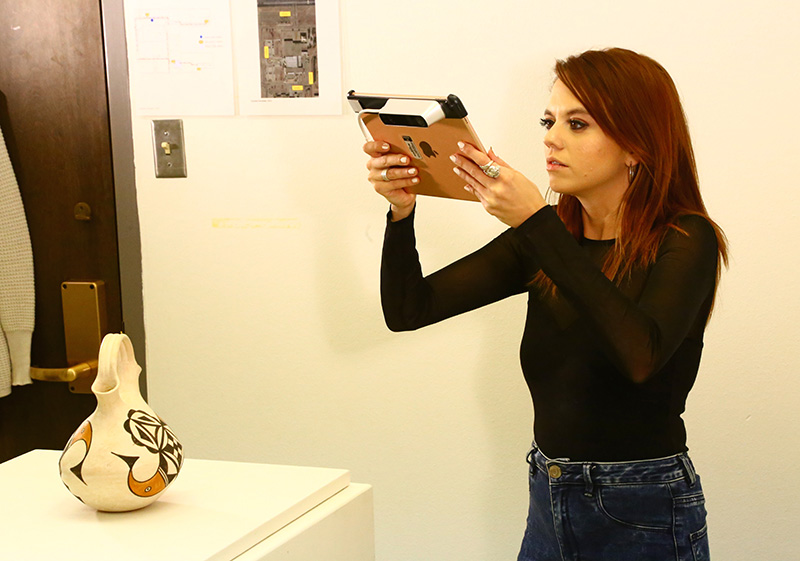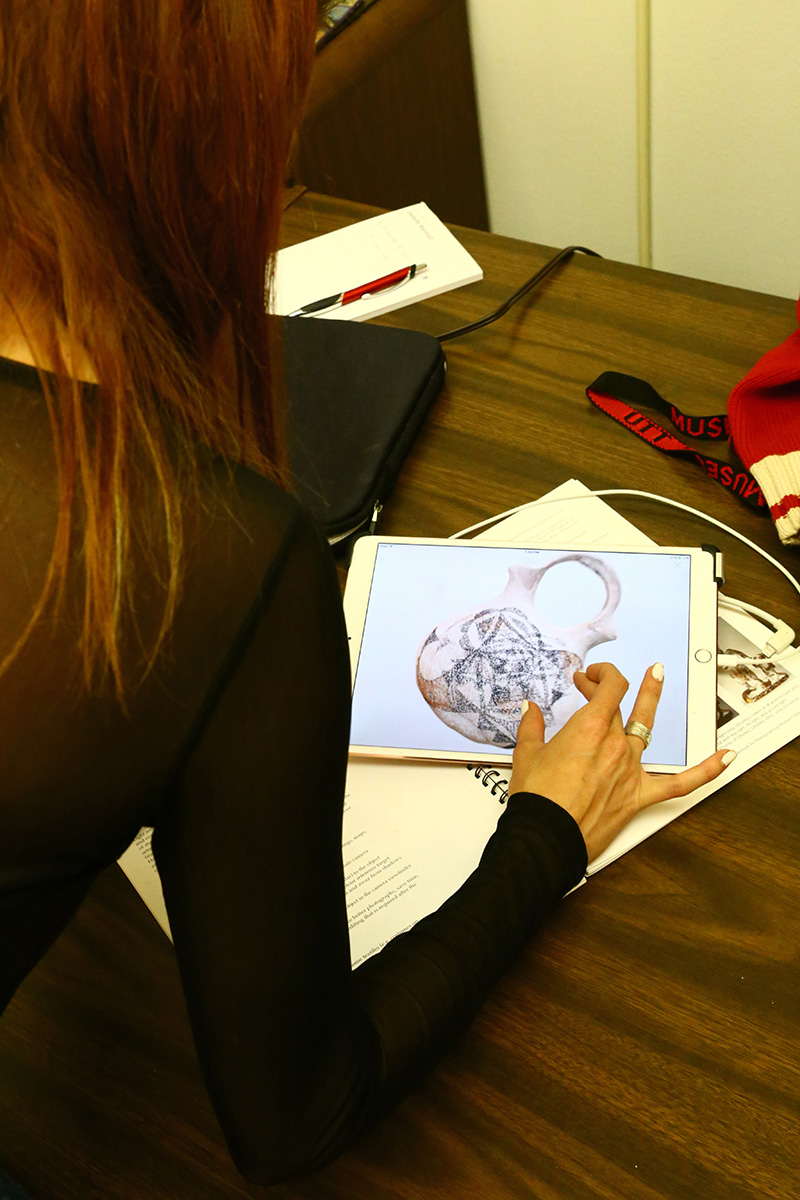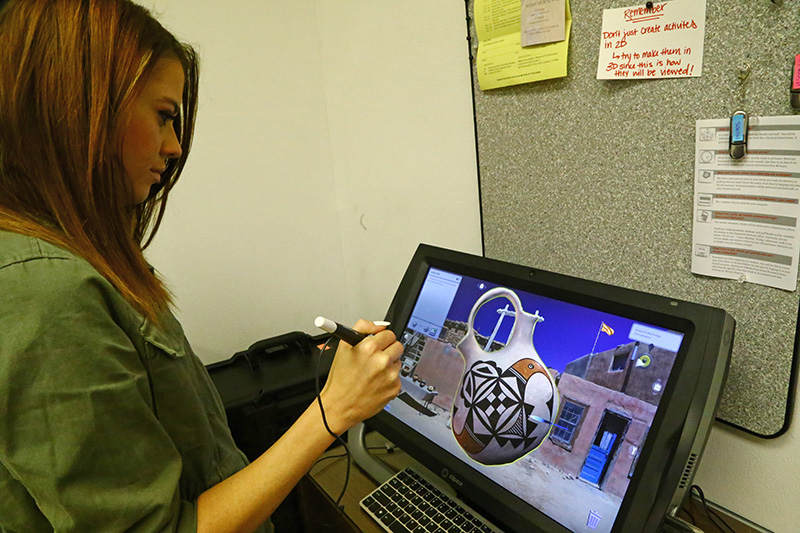Material Objects in a Virtual World
By Danielle Marshall
Heritage and Museum Sciences Graduate Student
Within the museum field, we normally do not classify our institutions as part of the service industry, however, maybe we should. The Museum of Texas Tech University is committed to serving the public, and in this process, we must consider the evolving trends of how most of society prefers to experience the world around them, which is through technology. Taking this commitment into account, the museum field must devise methods to incorporate new technologies through the enhancement of the educational experiences of interaction with the collection – and the Museum of Texas Tech University has a plan.
In summer 2017, I had the opportunity to sit in on a demonstration of a mixed-reality technology device called zSpace. The demonstration was hosted by Rebecca Hite, an assistant professor in the Texas Tech College of Education.
 The process begins by scanning an Acoma pottery piece using an iPad & attached 3D
Structure Sensor scanner.
The process begins by scanning an Acoma pottery piece using an iPad & attached 3D
Structure Sensor scanner.After a few minutes of experiencing the technology, I was instantly captivated. Shortly after meeting Dr. Hite, I quickly approached her with the notion of a research collaboration that involved her extensive knowledge of the technology and my connection to the Museum. The following semester, I enrolled in Dr. Stance Hurst's digital heritage course, to learn as much as I possibly could about the utilization of digital technologies as a tool for promoting cultural heritage within informal learning environments.
During the course, we had hands-on training with many forms of digital heritage techniques and topics, and we were instructed to choose a theme of the course to create a final digital heritage project. Inspired by the zSpace system, I chose to create a 3D model of an ancient camel skull from our collection at the Lubbock Lake Landmark. At the end of the semester, I had successfully made my first 3D model, loaded it onto zSpace, and had the opportunity to demonstrate the model on zSpace to my classmates. Seeing their reactions and how they utilized the system to interact with the model assured me that this technology needed to be somehow incorporated into the Museum.
One of the most culturally significant collections that the Museum holds in trust is the Davies Collection. This collection includes a wide range of stunning Southwest Indian art, that consists of pottery, katsina dolls, baskets, textiles, and ceremonial/ritual objects, all donated by William and Evelyn Davies. As the word traveled around the Museum about the zSpace system, it was suggested by Gary Morgan, the Museum's executive director, that we make a special effort to incorporate this technology within the William C. and Evelyn M. Davies Gallery of Southwest Indian Art Gallery, "Beyond Expressions in Clay." The goal of this project is to give the public a better understanding of collection objects through the use of interactive, 3D activities. When I was offered an internship to head up the project, I quickly signed on.
 The image is next put through a 3D modeling application called itSeez3D, creating
the base surface of Acoma pottery piece model and the textured wireframe surface is
examined to make sure it's works correctly.
The image is next put through a 3D modeling application called itSeez3D, creating
the base surface of Acoma pottery piece model and the textured wireframe surface is
examined to make sure it's works correctly.The technology works by incorporating elements of both augmented and virtual reality, using a modified desktop computer, to provide an interactive experience that promotes user-driven active learning. The system uses 3D glasses that have a series of embedded sensors that provide a perception of depth, making the object on the screen appear to come to life and float out of the screen. The zSpace system is extremely user-friendly, which allows users of all ages to have an interactive and memorable experience, without being intimidated by the technology. Using a stylus pen, the user can interact with an object and manipulate it to get a 360-degree view. An additional zoom in/out capability allows for examination of the objects as they hover in front of a user. For example, a visitor can pick up a pot or storyteller doll and turn it any direction, look inside it, or study a close-up view of the design, things that cannot happen with the real object.
Aside from the obvious entertainment value, the ability to enhance the educational experience is immense. The models are created using a software application called itSeez3D, which uses an iPad to make a continuous, wide-area scan of the object by traversing the object as the software renders a model. The scans create an extremely detailed model that can be edited if needed and then uploaded into the zSpace system. This transforms the collection from a traditional exhibit of stationary objects under glass to moveable objects that allow visitors to get an up-close and personal perspective. From this new perspective, visitors will be able to explore the collection through a new type of sensory experience.
The incorporation of zSpace with the Davies collection has two significant elements. The first is that the system allows us to create new forms of digital documentation of the collection, which can later be used remotely for scholarly research.
The second, and in my opinion the most important, focuses on the visitor experience. As a museum, it is our responsibility to provide innovative resources that can inspire visitors to establish a more personal connection to objects and to understand these objects as physical representations of a culture's heritage. Within museums, we use our collections to tell stories about the cultures that the artifacts represent, and to aid in telling these stories we must both invoke a will to learn and create an emotional experience. We must keep in mind that rather than designing our exhibits to be either educational or entertaining, we should ensure every effort is made to create a mindful blending of the two. More often than not, our interpretive materials are only as effective as the emotional connection a visitor has while interacting with them; and for many people, there is little to no interaction when reading text panels alone.
 Once the 3D model is finalized it is uploaded to the zSpace equipment. Visitors will
use 3D glasses that have a series of embedded sensors that provide a perception of
depth, making the object seemingly come to life and a stylus pen to interact with
an object and manipulate it to get a 360-degree view. Background photo of Acoma Pueblo, curtesy of Museum of Texas Tech photographer Bill
Mueller
Once the 3D model is finalized it is uploaded to the zSpace equipment. Visitors will
use 3D glasses that have a series of embedded sensors that provide a perception of
depth, making the object seemingly come to life and a stylus pen to interact with
an object and manipulate it to get a 360-degree view. Background photo of Acoma Pueblo, curtesy of Museum of Texas Tech photographer Bill
MuellerThe zSpace systems aids in this interpretive service by combining 3D models that incorporate visual realism of the object's appearance and perception of depth, to create a dynamic, informal learning environment. The zSpace system also uses encoded tracking within the glasses, and this allows for an object's spatial positioning to be customized based on how the user is moving his or her head. The sensation that the objects move in relation to how a visitor's head moves, provides the visitor with a feeling that they are not only interacting with the zSpace system but also that the zSpace system is interacting with them.
It is crucial to keep in mind that adding this type of technology to an exhibit space should always act as a tool of enhancement rather than replacing a traditional exhibit experience. Our goal is not to replace the original object, but to enhance the personal experience that visitors can have with objects in the museum.
To achieve this, the Museum's Education Division is creating corresponding activity guides to correlate with each object and culture. These guides, which are available with the object on the zSpace program, prompt users to interact with the objects in specific ways that allow users to learn more about historical and cultural significance.
The guides include background information, and true/false, multiple choice, and open-ended questions regarding the possible symbolism of patterns and stylistic choices. The user is then shown the correct answers, creating educational scaffolding that builds off of a user's knowledge to create an overall deeper understanding of the content. Using the guides is optional, and visitors can choose to use only parts of the guide. The element of choice as to how a user interacts with the objects and activities is vital in helping to achieve the project's goal of creating personal connections between our visitors and our collections. We believe this is the start to a new relationship between our visitors, our collections, and technology that will spark curiosity, create active learning, and help enhance the Museum's educational services to our public.
On a day-to-day basis, the majority of work within a museum is collection-driven, yet we must remember that it is our responsibility to inspire curiosity and create active learning for our visitors. The zSpace incorporation will open the possibilities of using augmented and virtual reality experiences within all of the collection divisions of the Museum and will provide a unique opportunity to interact with treasured artifacts in an innovative and exciting way.
Museum at Texas Tech University
-
Address
3301 4th Street, Lubbock, TX 79415 -
Phone
806.742.2490 -
Email
museum.texastech@ttu.edu
